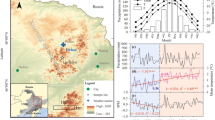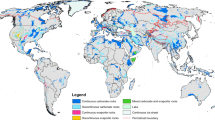Abstract
Dating saltmarshes is a fundamental step to conserve them suitably, because the oldest saltmarshes are becoming increasingly rare and host a particular biodiversity. In a French Atlantic saltmarsh, we counted tree rings on Suaeda vera, a ligneous plant of the European saltmarshes. We considered that the age of the stem may give the minimal age of the saltmarsh on which it grows as this is a specialist species of this habitat. By combining the dating of the saltmarsh using this proxy with a classical dating based on a photo-interpretation method, we found that the count of tree rings on S. vera gives an accurate dating of the minimal age of a saltmarsh patch. However, because of the rather low longevity of this species (maximum of 27 years in the investigated area), old maps and aerial photographs still remain essential to date the oldest saltmarsh patches. We further discuss: (1) the potential use of cross-dating on dead stems of the plant to reconstruct the long-history of saltmarshes; (2) the potential link between the growth velocity of S. vera and the spatial dynamics of saltmarshes.





Similar content being viewed by others
References
Adam P (1999) Saltmarsh ecology. Cambridge University Press, Cambridge
Adam P (2002) Saltmarshes in a time of change. Environ Conserv 29:39–61
Allard J, Bertin X, Chaumillon E, Pouget F (2008) Sand spit rhythmic development: a potential record of wave climate variations? Arçay Spit, Western coast of France. Mar Geol 253:107–131
Baily B, Inkpen R (2013) Assessing historical saltmarsh change; an investigation into the reliability of historical saltmarsh mapping using contemporaneous aerial photography and cartographic data. J Coast Conserv 17:503–514
Bakker JP (1983) Use and management of salt marshes on sand-dunes islands. In: Dijkema KS, Wolff WJ (eds) Flora and vegetation of the Wadden Sea Islands and Coastal Areas. Balkema, Rotterdam, pp 290–302
Barbier EB, Hacker S, Kennedy C, Koch EW, Stier AC, Silliman BR (2011) The value of estuarine and coastal ecosystem services. Ecol Monogr 81:169–193
Best USN, Van der Wegen M, Dijkstra J, Willemsen PWJM, Borsje BW, Roelvink DJA (2018) Do salt marshes survive sea level rise? Modelling wave action, morphodynamics and vegetation dynamics. Environ Modell Softw 109:152–166
Boorman L (2003) Saltmarsh review. An overview of coastal saltmarshes, their dynamic and sensitivity characteristics for conservation and management. JNCC Report 334
Costa MJ, Costa JL, Almeida PR, Assis C (1994) Do eel grass beds and salt marshes act as preferential nurseries and spawning grounds for fish? An example of the Mira estuary, Portugal. Ecol Eng 3:187–195
Costa MJ, Lopes MT, Domingos IM, Almeida PR, Costa JL (1995) Portuguese Fauna Working Group—Tagus and Mira sites. In: Lefeuvre JC (ed) The effects of environmental change on European saltmarshes: structure, functioning and exchange potentialities with marine coastal waters, vol 3. University of Rennes, Rennes, pp 95–174
Daiber FC (1977) Saltmarsh animals: distributions relating to tidal flooding salinity and vegetation. In: Chapman VJ (ed) Wet coastal ecosystems. Elsevier, Amsterdam, pp 79–108
Dame RF, Kenny P (1986) The variability of Spartina alterniflora productivity in the North Inlet estuary. Mar Ecol Prog Ser 32:71–80
Decuyper M, Slim PA, Van Loon-Steensma MJ (2014) Dendrochronology of Atriplex portulacoides and Artemisia maritima in Wadden Sea salt marshes. J Coast Conserv 18:279–284
Descender K, Maelfait JP (1999) Diversity and conservation of terrestrial arthropods in tidal marshes along the River Schelde: a gradient analysis. Biol Conserv 87:221–229
Dijkema KS (1984) Salt Marshes in Europe. European Committee for the Conservation of Nature and Natural Resources, Strasbourg, pp 152–156
Fritts HC (1976) Tree rings and climate. Academic Press, New York
Géhu JM (1979) Etude phytocoenotique analytique globale de l’ensemble des vases et prés salés et saumâtres de la face Atlantique Française. Convention de recherche No.77-29.
Godet L, Pourinet L, Joyeux E, Verger F (2015) Dynamique spatiale et usage des schorres de l’Anse de l’Aiguillon de 1705 à nos jours. Enjeux de conservation d’un patrimoine naturel littoral marin. Cybergeo Eur J Geogr 17:503–514
Goeldner-Gianella L (2000) L’Allemagne et ses polders. CTHS, Paris
Gray AJ (1972) The ecology of Morecambe Bay V. The salt marshes of Morecambe Bay. J Appl Ecol 9:207–220
Gray AJ, Pearson JM (1984) Spartina marshes in Poole Harbour, Dorset. In: Doody P (ed) Spartina anglica in Great Britain. Nature Conservancy Council, Attingham Park, pp 11–14
Grigore MN, Toma C (2017) Anatomical; adaptations of halophytes: a review of classic literature and recent findings. Springer, Berlin
Guetté A, Joyeux E, Corre F, Haie S, Godet L (2016) Old and unmowed saltmarsh patches provide attractive habitats for breeding passerines. Wetl Ecol Manage 24:477–493
Habitats Directive (1992) Council directive 92/43/EEC of 21 May on the conservation of natural habitats and of wild fauna and flora. Official Journal of the European Communities 206 22/07/1992
Hather JG (2009) The identification of northern European woods: a guide for archaeologists and conservators. Routledge, London
Hurlbert SH (1983) Pseudoreplication and the design of ecological field experiments. Ecol Monogr 54:187–211
Marker ME (1967) The Dee Estuary: its progressive silting and saltmarsh development. T I Brit Geogr 41:65–71
Möller I, Kudella M, Rupprecht F, Spencer T, Paul M, van Wesenbeeck BK, Wolters G, Jensen K, Bouma TJ, Miranda-Lange M, Schimmels S (2014) Wave attenuation over coastal salt marshes under storm surge conditions. Nat Geosci 7:727–731
Parkinson M (1985) The Axe estuary and its marshes. Rep Trans Devonshire Assoc Adv Sci 117:19–62
Poirier C, Tessier B, Chaumillon E, Bertin X, Fruergaard M, Mouazé D, Noël S, Weill P, Wöppelmann G (2017) Decadal changes in North Atlantic atmospheric circulation patterns recorded by sand spits since 1800 CE. Geomorphology 218:1–12
Schweingruber FH (2007) Wood structure and environment. Springer, Berlin
Schweingruber FH, Landolt W (2010) The Xylem Database, Swiss Federal Research Institute WSL, Switzerland. https://www.wsl.ch/dendropro/xylemdb/
Steers JA (1964) The coastline of England and Wales. Cambridge University Press, Cambridge
Stokes MA, Smiley TL (1996) An introduction to tree-ring dating. University of Chicago University Press, Chicago
Verger F (2009) Zones humides du littoral français : Estuaires, deltas, marais et lagunes. Belin, Paris
Whittaker RH (1975) Communities and ecosystems, 2nd edn. Macmillan, New-York
Wigley TML, Jones PD, Briffa KR (1987) Cross-dating methods in dendrochronology. J Archaeol Sci 14:51–64
Acknowledgements
We thank Jacques Marquis (ONCFS) for facilitating the access to the study site, and Louis Mesona for his help in the field and in the lab. Special thanks to Allya Le Peigne for helpful comments on a first draft of this manuscript.
Funding
This research was supported by the Observatoire des Sciences de l’Univers de Nantes Atlantique (OSUNA).
Author information
Authors and Affiliations
Contributions
LG and AD designed the field sampling. CP mosaicked and georeferenced the aerial photographs. AD performed the tree-ring count at the laboratory. LG and AD did the analyses. LG, AD and CP wrote the manuscript.
Corresponding author
Ethics declarations
Conflict of interest
All authors declare that they have no conflict of interest.
Additional information
Publisher's Note
Springer Nature remains neutral with regard to jurisdictional claims in published maps and institutional affiliations.
Rights and permissions
About this article
Cite this article
Godet, L., Decaulne, A. & Poirier, C. Dating saltmarshes using tree rings on a halophilous plant. Wetlands Ecol Manage 28, 815–823 (2020). https://doi.org/10.1007/s11273-020-09751-y
Received:
Accepted:
Published:
Issue Date:
DOI: https://doi.org/10.1007/s11273-020-09751-y




